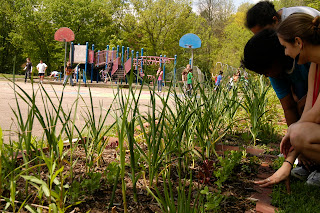After a long, drawn out winter, the sun is out and we are back in the dirt! We were greeted by some vivacious garlic plants that had been hibernating under the snow all winter long.
here are some things we learned about garlic today:
- Allium sativum, is a species in the onion genus, Allium. Its close relatives include the onion, shallot, leek, chive,andrakkyo.
-Garlic has been used throughout history for both culinary and medicinal purposes. The garlic plant's bulb is the most commonly used part of the plant. With the exception of the single clove types, the bulb is divided into numerous fleshy sections called cloves. The cloves are used for consumption (raw or cooked), or for medicinal purposes, and have a characteristic pungent, spicy flavor that mellows and sweetens considerably with cooking.
-The leaves and flowers (bulbils) on the head (spathe) are also edible, and being milder in flavor than the bulbs,they are most often consumed while immature and still tender.-garlic has been found to have antibacterial, antiviral, and antifungal activity. Garlic is also claimed to help prevent heart disease (includingatherosclerosis, high cholesterol, and high blood pressure) and cancer] Garlic is used to prevent certain types of cancer, including stomach and colon cancers. In fact, countries where garlic is consumed in higher amounts, because of traditional cuisine, have been found to have a lower prevalence of cancer
The herb spiral is green and vibrant, the herbs smell really sweet
 Along with garlic and onions, we planted sugar snap peas, lettuce, spinach, and radishes. The peas are coming up quickly, searching for a trellace to crawl up! Looks like we gotta make a trellace!
Along with garlic and onions, we planted sugar snap peas, lettuce, spinach, and radishes. The peas are coming up quickly, searching for a trellace to crawl up! Looks like we gotta make a trellace!
After planting radish seeds last week, we were so excited to see all of the tiny sprouts popping up. It is time to thin out the rows so that each plant has enough space and nutrients from the soil.
thinning
was
a
lot
of
work!
The radish (Raphanus sativus) is an edible root vegetable of the Brassicaceae family that was domesticated in Europe,in pre-Roman times. They are grown and consumed throughout the world. Radishes have numerous varieties, varying in size, color and duration of required cultivation time. There are some radishes that are grown for their seeds; oilseed radishes are grown, as the name implies, for oil production.
We added the beautiful stepping stones we made in garden arts this past winter. The shells and marbles are the perfect addition to our beds.
















